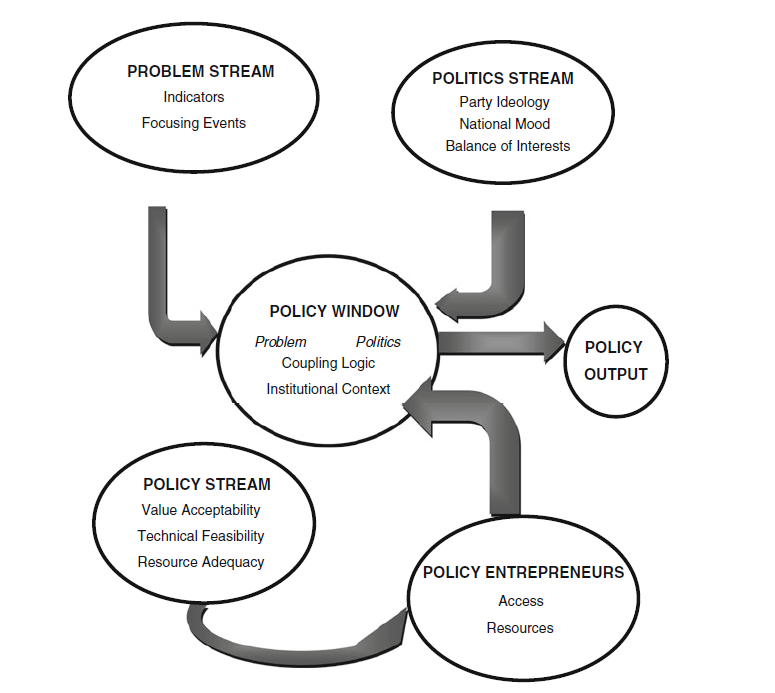Thank you for your message. The IPPA team will get back to you shortly. You first need to login here.


Bounded rationality models and their closely related garbage can family of models have emerged as important ways of examining national policy-making when goals are not widely shared, attention is fleeting, time is scarce, the choice is biased by framing effects, and collective benefits differ from individual interests. Under these conditions the utility of optimizing rationality is limited. Instead, Simon’s logic of bounded rationality stresses cognitive, computational, and organizational limitations in rational problem-solving while March and Olsen’s garbage cans and Kingdon’s multiple streams add the concepts of ambiguity and temporal sorting as fundamental steps in understanding how policies are made and legitimated. This page reviews their intellectual development, identifying their differences and similarities and specifying their benefits and drawbacks. The approaches supplement but do not supplant rationality. They remain fundamentally embedded within broader information processing and interpreting stream of research, indicating limitations and explaining deviations and pathologies. Both frameworks hypothesize robust processes that more closely match empirical observations of how policy is actually made, but doing so also complicates them substantially by increasing the amount of information needed to explain or predict public policies.
In the following, we briefly describe the origin and development of the approaches, Bounded Rationality, Garbage Cans model, and Multiple Streams. This will be followed by Professor Zahariadis talk on the development of these models, extending them to the entire policy-making process.
Herbert Simon is the author of the two foundational works Administrative Behaviour (1976) and Organizations (1958, co-authored with James March) who first articulated and developed the concept of bounded rationality.
The bounded rationality as explained by Simon assumes that individuals and the environment basically see policy-making subject to individual decisions and institutional aggregation. The basic assumption is that that rationality is directed toward some goals, thus it is bounded and confined. Indeed, individuals face computational, cognitive and organizational limits in rational problem-solving. This significantly leads to bias in the attention, search and selection procedures.
In addition, Simon states that other factors such as “environmental clues, roles, and perceptions” also affect decision processes.
Bounded Rationality adds an organizational dimension to the decision-making process. It contends that organizations are social institutions, which manage conflict among decision participants in different ways. For instance, organizations factor problems into smaller pieces that are then distributed to different agencies for analysis. Solutions are then aggregated (with all the biases this process entails), and decisions are made based in part on how political conflict is managed at the upper management level.
In the below video, Simon talks about decision-making and Bounded rationality.
Overall, the concept of bounded rationality has found its way into most decision-making models. While not developed as a policy-making model, it enriches explanations that more closely match empirical observations of how policy is actually made.
The garbage can model of organizational choice was initially introduced by Cohen et al. (1972) and later adapted by Kingdon (1995) as a framework of policy-making. The Garbage Can model Of organizational choice has become over time one of the indispensable perspectives on organizational thinking, in particular, and social theory, in general. It explains much more than the specific issue of the decision process.
To understand the decision-making process within organizations, one can see the opportunity for choice as a garbage can, in which various types of problems and solutions are thrown by the participants as soon as these are elaborated. The mix of the garbage in a single bin depends on the bins available, the labels attached to the alternative bins and the type of garbage being produced at the time, as well as the speed with which the garbage is collected and removed from the scene.
This theory of decision making in organizations must consider a relatively complicated interaction between the generation of problems in an organization, the deployment of personnel, the production of solutions and the opportunity for choice
John Kingdon (1984) adapted the garbage can model to the policy process. In his book, he examines why some issues are given more importance while others are being neglected. He identifies the interplay of three relatively independent factors (he calls them streams) namely problems, policy and politics as crucial in influencing the process of agenda-setting. The interplay (or coupling) of these streams by policy entrepreneurs in particular moments in time (called policy windows) explains why agendas are set in specific ways.
Zahariadis applies Kingdon’s argument to the entire process of policy-making. He explains that each stream has its own dynamics and limits. The criteria that promote issues to the top in the problem stream include indicators, focusing events, feedback, and problem load. Not every idea becomes a solution to be examined by policymakers. Technical feasibility, value acceptability and the extent of integration in sub-systematic policy networks affect the trajectory and speed of solutions in the policy stream. Similarly, party ideology, national mood and political turnover determine the “ripeness” of the political stream.
The main idea is that contrary to conventional wisdom policies don’t always solve the problems they are designed. Rather a mix of contextual factors provides a more empirically accurate explanation.
In the diagram below, Zahariadis illustrates the multiple streams framework in policy-making processes.

Nikolaos Zahariadis is Mertie Buckman Chair and Professor of International Studies at Rhodes College in Memphis, TN, USA. His research focuses on explorations of policymaking at the intersection of domestic and international affairs with a substantive emphasis on political economy and (lately) migration issues. He has twice been a Fulbright Scholar, a Policy Studies Organization Fellow, a National Bank of Greece Senior Research Fellow, an ESRC-SSRC Fellow as well as President of the International Studies Association-South. His work has been published by major presses – such as University of Michigan Press, Georgetown University Press, Routledge, Springer, and others – and has appeared in key journals – such as Policy Studies Journal, Journal of European Public Policy, Policy Sciences, International Studies Quarterly, Comparative Political Studies, and others. Apart from being an Elvis Presley fan in America’s capital of the blues, he enjoys tasting barbeque food in small and unassuming restaurants.
- Cohen, M. D., March, J. G., & Olsen, J. P. (1972). A garbage can model of organizational choice. Administrative Science Quarterly, 1-25.
- Kingdon, J. W. (1984). Agendas, Alternatives, and Public Policies Boston: Little, Brown.
- Simon, H. A. (1997). Models of Bounded Rationality: Empirically Grounded Economic Reason (Vol. 3). MIT Press.
- Zahariadis, N. (2016). Bounded rationality and garbage can models of policy-making. In Contemporary Approaches to Public Policy (pp. 155-174). Palgrave Macmillan, London.
- Administrative Behaviour by HA Simon
- Organizations by HA Simon and JG March
- Bounded rationality and garbage can models of policy-making by N Zahariadis
- Agendas, Alternatives, and Public Policies by JW Kingdon

Thank you for your message. The IPPA team will get back to you shortly. You first need to login here.